
Lower Columbia Salmon Fishing Closed
Columbia salmon managers voted to shut down the big river from Buoy 10 to Bonneville Dam to Chinook, coho and steelhead fishing, effective 11:59 p.m. tonight.
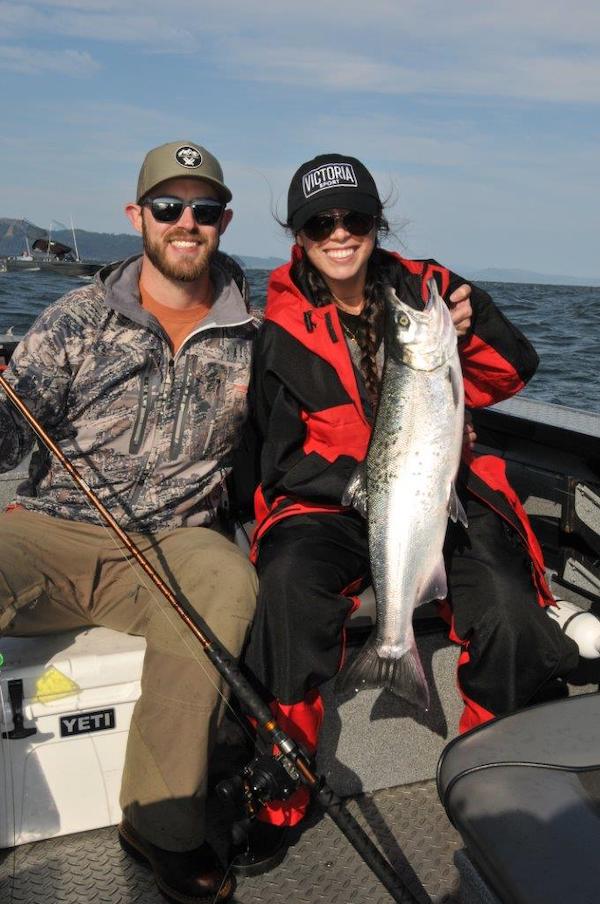
Anglers and guides had hoped ODFW and WDFW could carve out some opportunity to keep plentiful hatchery coho at the mouth of the river and upriver brights in the western Columbia Gorge open, but even those limited fisheries would likely still catch natural-origin tule fall Chinook, and impacts on that ESA-listed stock have been exceeded by some margin.
“This is a big deal. These are not decisions taken lightly,” said ODFW’s Columbia salmon manager Tucker Jones during this morning’s Columbia River Compact call. “I’m sadly fully in support of the staff recommendation” to close the river from the dam through the estuary.
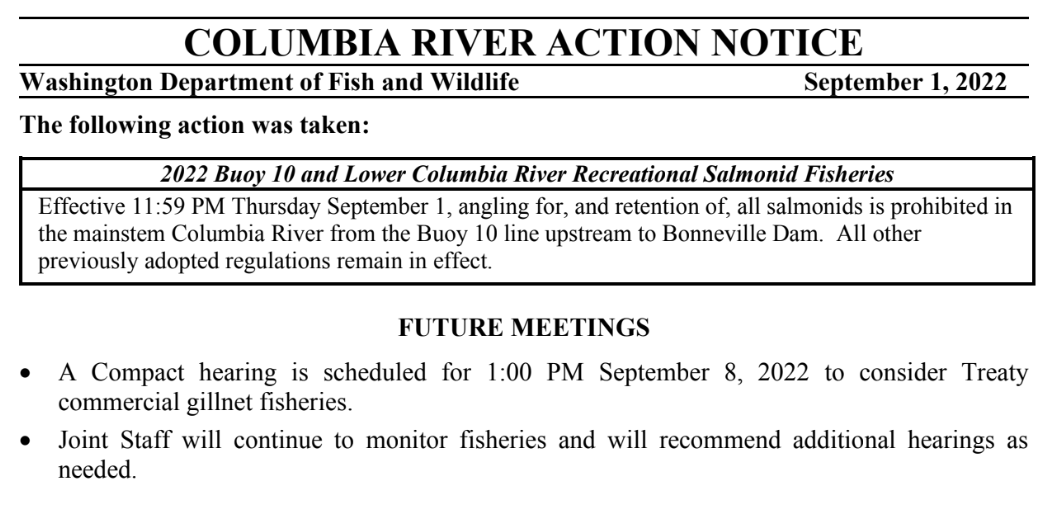
The move comes right before the extended Labor Day Weekend and scrubs a planned bump to three-hatchery-coho daily limits as of September 8, though managers expressed hope in finding a way to reopen the fishery as soon as possible.
It was a bitter pill for Jones and his theory of salmon management.
“I believe in the value of these fisheries,” he said in the lead-up to the decision. “I think of these fisheries as part of the conservation mission,” keeping anglers involved in the fishery, small businesses in business and harvesting hatchery fish.
But neither he nor his counterpart on the north side of the Columbia, WDFW’s Dr. Charlene Hurst, saw any other option but to shut the lower river down in the near term.
“We are over our recreational fishery allocation,” Hurst stated flatly. “I don’t see an option to do anything other than the staff recommendation.”
Federal overseers didn’t have a vote but supported DFW staffers’ recommendation as well.
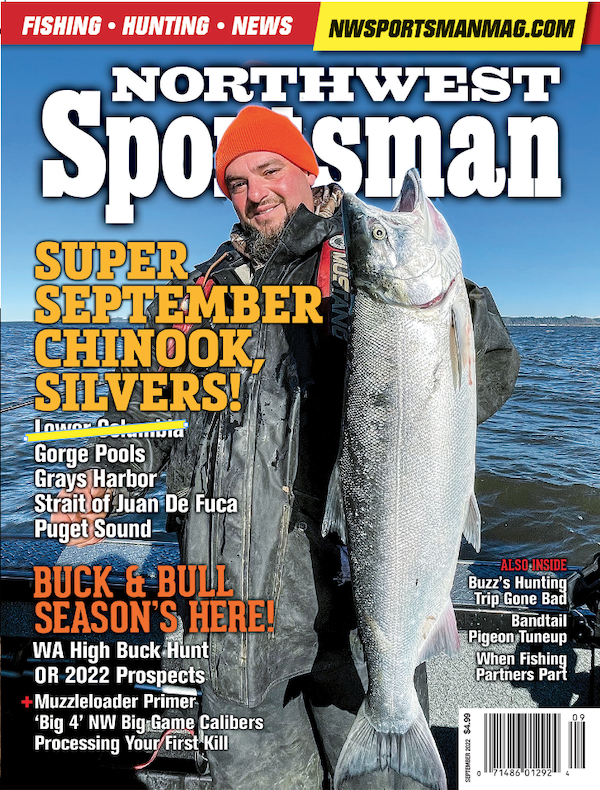
A fact sheet that came out last night from both agencies’ staffers show that catches of wild tules hit 109 percent of preseason expectations at Buoy 10, with expectations exceeded during both the 24-day hatchery-only and six-day nonselective Chinook fisheries, 111 and 232 percent, respectively.
“Fishing has been extremely good, catch rates have been high,” stated ODFW’s Jeff Whisler.
He said a three-day mid-August stretch of soft, “bathtub” tides saw the “highest handle rates we’ve ever seen,” including during 2013-15’s incredible returns of fall Chinook. Alongside tules swim much more plentiful upriver brights, which return to waters east of the Cascades including the Hanford Reach.
And per Whisler those high catch rates returned on August 30, the last day of king retention, a Chinook per angler, which is really good fishing and the daily limit for the species. Late Monday afternoon, his agency sent out word that Tuesday the 30th would be the last day for kings, cutting short a season that had been scheduled to run through September 7, if enough fish remained in the quota.
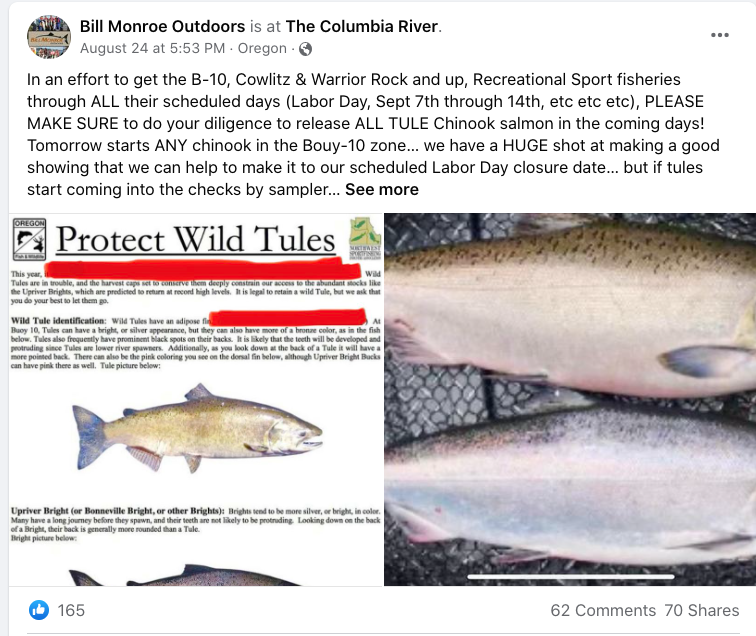
During public comment, even as the general feeling was of resignation to the inevitably of the DFWs’ move, some anglers and guides offered ideas such as keeping the waters from Rooster Rock to the dam and from Buoy 14 down to Buoy 10 open for URBs and coho, respectively, as well as asking anglers to fish shallower and later in the tides.
Guide Bob Kratzer worried about how a closure would just shift pressure to the Cowlitz and North Fork Lewis, where many of the tules are returning. He forecasted “a pile of people hover fishing and hooking fish in the throat with eggs.”
Larry Phillips, a former WDFW regional manager who is now with the American Sportfishing Association, acknowledged the complexity of the fishery, but wondered if whether inseason actions had been taken earlier to reduce tule impacts there might have been some options now to keep areas open.
One angler spoke to how he’d talked a friend into coughing up $500 to come up and fish the Columbia for 14 days in September.
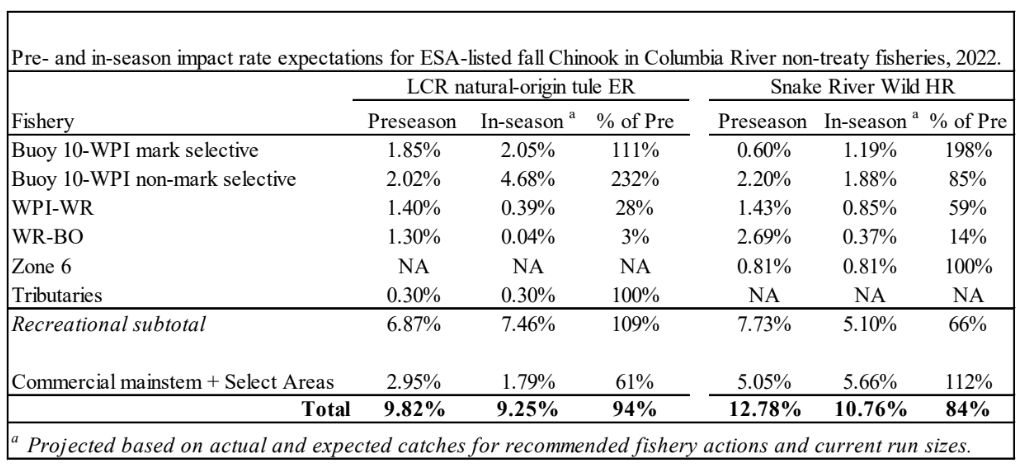
Marvin Hinkle said that a closure would be devastating to Astoria, which had been planning on crowds to be in town, and noted that the states had bragged about the size of the coho run. An Astoria guide reported that this morning he and his clients had brought 24 coho to the side of the boat in search of hatchery keepers, and they had not caught a single Chinook.

There’s a feeling that the high catch of tules means that run is much bigger than forecast, and indeed, thanks to improved ocean conditions, salmon runs have begin to shine again. This year’s sockeye return up the Columbia was more than three times as large as initially predicted and set a new record, and the A-run of steelhead forecast was upgraded earlier this week from 81,000 to 98,000.
But it could also be that the tules just aren’t moving upriver. ODFW’s Jimmy Watts said that usually they clear out of the estuary by the 20th, but this year they didn’t, perhaps because of a lack of rain.
Last Monday evening, ODFW reported catch stats for this fishery that opened August 1:
“Through Aug. 28, an estimated 26,000 Chinook and 5,000 hatchery coho were kept from 67,800 angler trips in the Buoy 10 fishery. Released estimates include 20,300 Chinook, 3,200 coho, and 70 steelhead. Through Aug. 28, there have been 29,800 total Chinook mortalities compared to the preseason expectation of 32,850 for the full season. Additional Chinook release mortalities will continue to accrue during the coho fishery.”
THE FOLLOWING ARE PRESS RELEASES FROM THE OREGON AND WASHINGTON DEPARTMENTS OF FISH AND WILDLIFE
CLACKAMAS, Ore.—Fishery managers from Oregon and Washington closed all salmonid (salmon and steelhead) fishing, including both retention and catch-and-release fishing, on the Columbia River from Buoy 10 to Bonneville Dam as of tonight, Thursday Sept. 1 at 11:59 p.m.
Higher than expected catch, effort, and handle rates of lower Columbia River tule fall Chinook in the Buoy 10 fishery have put the recreational fishery over its allowable impact limit for this ESA-listed stock, which is the most constraining salmon stock this time of year. (Non-treaty fisheries remain within their overall impact limits.)
Chinook handle (and ESA impacts) were more than double expected rates during the non-mark-selective portion of the Buoy 10 fishery with some of the highest handle rates of fall Chinook ever observed, one fish per angler on some days. Even after Chinook retention closed at Buoy 10, Chinook handle remained high in the coho-directed fishery with about 750 fall Chinook being released yesterday by Oregon anglers.
“This closure is a big deal and a decision not taken lightly, but we’ve got to do this to ensure fisheries remain within their conservation limits on these listed runs of fish,” said Tucker Jones, ODFW’s Ocean Salmon and Columbia River Program Manager. “It kills us to have to close fishing before Labor Day Weekend, especially when we recognize how important recreational angling is to both the conservation of salmon and to the economics of local communities that rely on this fishery.”
“Unfortunately, closing is our only option right now. But we are committed to getting folks back on the water as soon as possible, if it’s possible,” he continued “We’ll also be looking ahead to next year and thinking about how to do things differently to try and avoid this outcome in the future.”
Chinook retention had closed at Buoy 10 after Aug. 30 and in the ocean recreational fishery from Leadbetter Point to Cape Falcon after Aug. 22. Steelhead retention was already closed.
Fishery biologists are continuing to track and update runs. Salmon fishing could reopen downstream of Bonneville to target this year’s large coho run at Buoy 10 or upstream of the Lewis River if it’s determined fisheries could be held and not further meaningfully impact lower river tule Chinook salmon.
With the closure, all angling for, and retention of, salmonid species (Chinook, coho, steelhead, sockeye) is closed on the Columbia River downstream of Bonneville Dam. Angling for shad, walleye and other warmwater species remains open under permanent regulations, and sturgeon fisheries scheduled for later this month are not affected.
Check for the latest fishing regulations by visiting ODFW’s Recreation Report – Fishing Report for your zone and clicking Regulation Updates https://myodfw.com/recreation-report/fishing-report/columbia-zone
NEWS RELEASE
Washington Department of Fish and Wildlife
Sept. 1, 2022
Contact: WDFW Southwest Region, 360-696-6211
Public Affairs contact: Ben Anderson, 360-902-0045
Salmon fishing to close on Columbia River mainstem from Buoy 10 to Bonneville Dam
OLYMPIA – With Chinook salmon catches trending well above expectation, fishery managers from Washington and Oregon announced today that the lower Columbia River from Bonneville Dam to Buoy 10 (including the Camas Slough) will close to salmon fishing beginning Friday, Sept. 2.
Fishery managers with the Washington Department of Fish and Wildlife (WDFW) and Oregon Department of Fish and Wildlife agreed Thursday to close salmon fishing downstream of Bonneville Dam after preliminary data showed impacts to Lower Columbia River “tule” Chinook – which are listed as threatened under the Endangered Species Act (ESA) – were much higher than anticipated.
The Buoy 10 fishery near the mouth of the Columbia opened for mark-selective hatchery Chinook fishing on Aug. 1 and switched to non-mark selective fishing on Aug. 25, with the catch rate particularly high during the non-mark selective portion. From Aug. 25-30, an estimated 11,800 Chinook were kept in the Buoy 10 fishery, with another 3,500 released.
“Anglers saw a lot of success in August fishing for Chinook at Buoy 10,” said Ryan Lothrop, Columbia River fisheries manager with WDFW. “Normally, these tule Chinook begin to move out of the area in late August, but we saw catches increase in the past week and the proportion of tules caught was much higher than we’ve seen in years past. Unfortunately, this pushed us over the allowable recreational impacts on these lower river Chinook.”
Unlike other fall Chinook stocks that return upstream of Bonneville Dam, there is no method for updating the estimated return of tule Chinook below Bonneville Dam in-season. Therefore, fishery managers must rely on pre-season estimates when determining how many impacts are allowed to ESA-listed populations below Bonneville Dam through the duration of the fishing season.
“Even in a coho-only fishery, some Chinook are still caught and die after release,” Lothrop said. “It’s not clear if the lower river tule stock is coming in above our pre-season forecast, or if these fish are just sticking around longer than normal. Either way, we have to make sure we don’t exceed allowable impacts to this population.”
Managers will continue to monitor the fisheries and runs to evaluate if there is a possibility to reopen for salmon fishing later this fall.
Salmon fishing remains open in much of the Columbia River mainstem above Bonneville, as well as many lower river tributaries and the ocean. Anglers are encouraged to review the 2022-23 Washington Sport Fishing Rules pamphlet for permanent regulations, and check for potential emergency rule updates to these fisheries before heading out.

